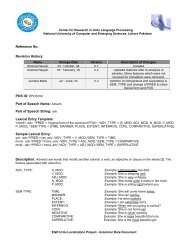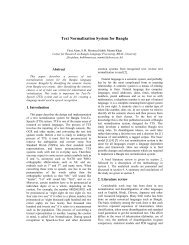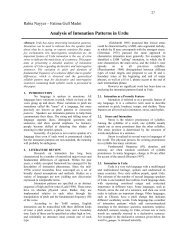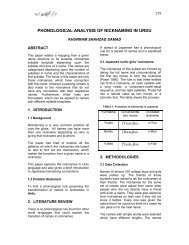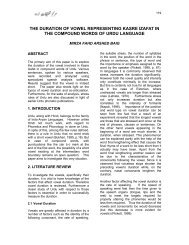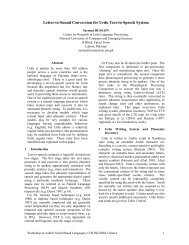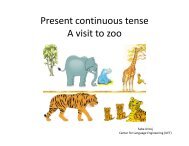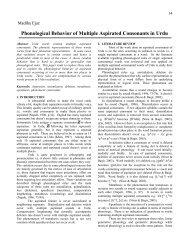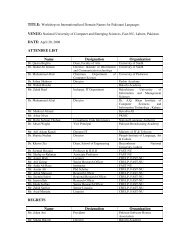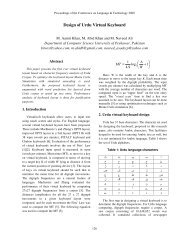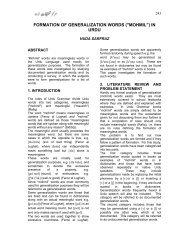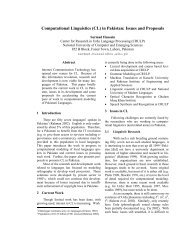Phonological Behavior of Aspirated Consonants in Urdu
Phonological Behavior of Aspirated Consonants in Urdu
Phonological Behavior of Aspirated Consonants in Urdu
You also want an ePaper? Increase the reach of your titles
YUMPU automatically turns print PDFs into web optimized ePapers that Google loves.
five dictionaries (Ahmed, 2002), (Feroze-ud-D<strong>in</strong>), (Haqi,1995), (Nayyar, 1989), (Platts, 1911). Those words wereselected for analysis, which showed some variation withaspiration. Some other words were also selected whichconta<strong>in</strong>ed aspirated consonants but are spoken differentlyfrom their pronunciation given <strong>in</strong> the dictionary. Inappendix these words are differentiated with a ‘*’ <strong>in</strong>superscript (e.g. word * ). We have <strong>in</strong>cluded only thosevariations, which were clearly stated <strong>in</strong> most <strong>of</strong> thedictionaries. In some cases dictionaries gavecontradictory data. For reach<strong>in</strong>g to a decision only thosewords were <strong>in</strong>cluded which were present <strong>in</strong> at least three<strong>of</strong> the reference dictionaries. To choose the base formfrom different variations <strong>of</strong> a word, we used thedictionary by John T. Platts as reference as it was theoldest published from all other dictionaries. All thosewords, which conta<strong>in</strong>ed their mean<strong>in</strong>gs as well as theirother variations, were taken as base form words.4.2 Analysis <strong>of</strong> DataTo see which rule applied to a given set <strong>of</strong>words, the syllable structure and stress <strong>in</strong> the syllableswas analyzed. The context, i.e. the features <strong>of</strong>neighbor<strong>in</strong>g segments, <strong>in</strong> which aspiration exhibitedvariation, was also considered. To represent thephonological rules both l<strong>in</strong>ear and autosegmentalrepresentations were considered and the representationthat best expla<strong>in</strong>ed the data was chosen.5. RESULTS5.1 DeletionAnalysis <strong>of</strong> data showed that deletion <strong>of</strong>aspiration from aspirated consonants occurs at twodifferent places <strong>in</strong> words. Rule 5.1(a) describes deletion<strong>of</strong> aspiration from the consonant at word boundary. Fore.g. /t h et h / becomes [t h et].[+asp]X #[+cons]except for /k/Rule 5.1(a) Deletion <strong>of</strong> aspiration from aspiratedconsonants at word boundary <strong>in</strong> wordsIn Rule 5.1(a), ‘#’ represents word boundary.The data for this rule is given <strong>in</strong> the Appendix A.1.Deletion <strong>of</strong> aspiration from consonant occurr<strong>in</strong>g medially<strong>in</strong> the word is given by Rule 5.1(b). For example the word/ob h i/ becomes [obi]. The data analyzed for Rule5.1(b) is given <strong>in</strong> the Appendix A.2.While analyz<strong>in</strong>g the data, it was observed thataspiration from the consonant present at the beg<strong>in</strong>n<strong>in</strong>g <strong>of</strong>the word is never deleted.[+asp]X 1 X 2 X 3[+son][+obs][+son]except when X 1 = V and X 3 = NRule 5.1(b) Deletion <strong>of</strong> aspiration from aspiratedconsonants occurr<strong>in</strong>g medially <strong>in</strong> words5.2 MetathesisThe words show<strong>in</strong>g metathesis with aspirated consonantswere very limited. Due to dependency <strong>of</strong> rule on a lot <strong>of</strong>factors, the phonological rule for metathesis could not beformulated, either <strong>in</strong> l<strong>in</strong>ear form or <strong>in</strong> autosegmentalform. For example the word /k∂t h t h a/becomes [k h ∂tta]. Words <strong>in</strong> which metathesisoccurs is given <strong>in</strong> the Appendix B.It was noticed that aspiration <strong>of</strong> consonant occurr<strong>in</strong>g atthe beg<strong>in</strong>n<strong>in</strong>g <strong>of</strong> word is never shifted (e.g. /b h ∂rna/).5.3 InsertionThe stem’s last consonant becomes aspiratedwhenever the suffixes /e/ and /i/ are added to the stems<strong>of</strong> closed class words. For e.g. when suffix /i/ is added to/n/ it becomes [n h i] . The data correspond<strong>in</strong>g to<strong>in</strong>sertion is given <strong>in</strong> the Appendix C. Rule 5.3 shows the<strong>in</strong>sertion <strong>of</strong> aspiration.[+asp]XX+ X[+syl] [-cont] [+syl][+ant] [-back][+voiced] [+tense][-low]XRule 5.3 Insertion <strong>of</strong> aspiration[+syl][-cont][+syl][+ant] [-back][+voiced][+tense][-low]5.4 DissimilationThe process <strong>of</strong> dissimilation <strong>of</strong> aspiration <strong>in</strong><strong>Urdu</strong> is described <strong>in</strong> Rule 5.4.[+asp]XV (V) (C).XXXRule 5.4 Dissimilation <strong>of</strong> aspiration



